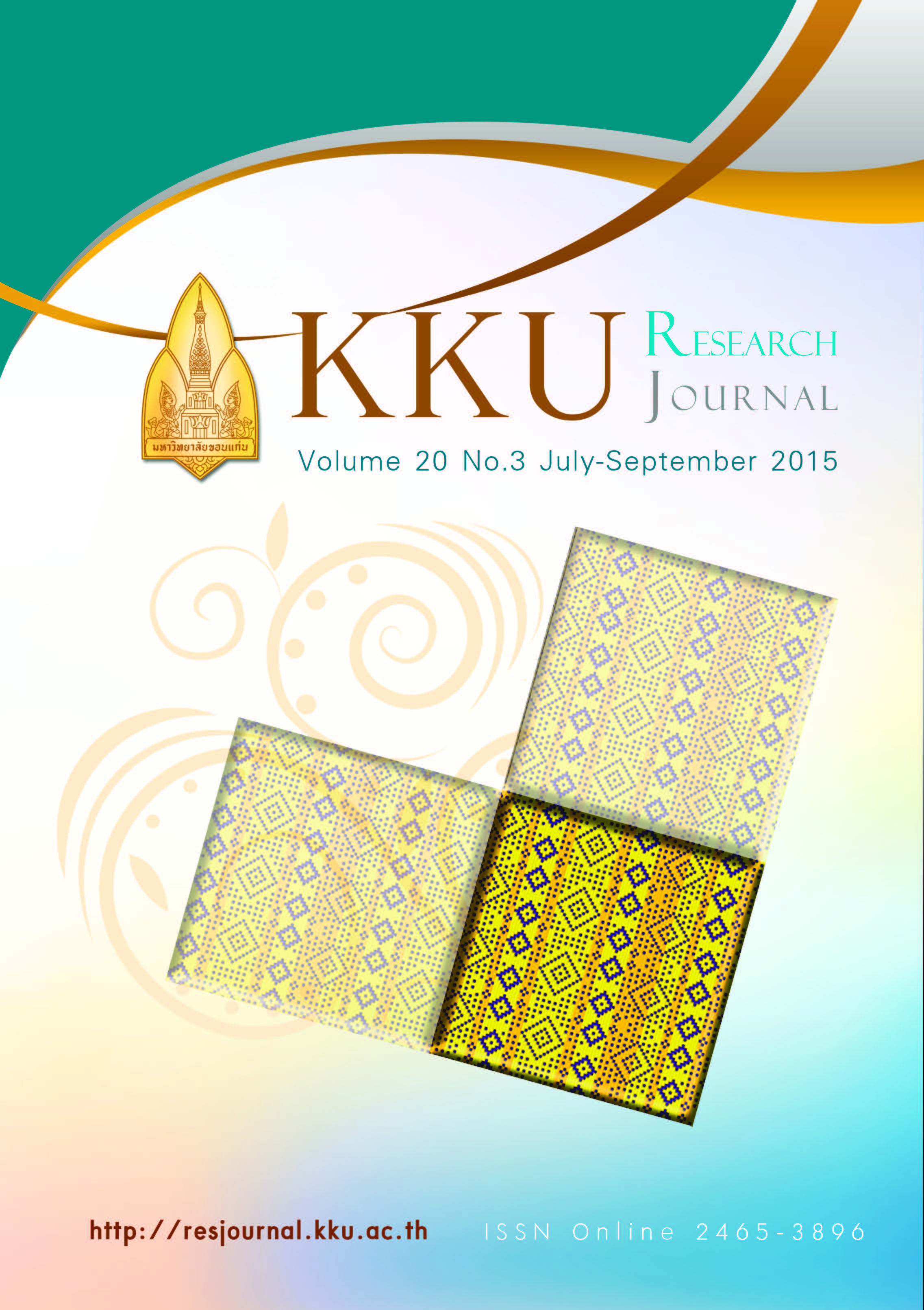The use of mangosteen pericarp (Garcinia mangostana L.) extract to fortify the green tea drink enchanced antioxidant activity.
Main Article Content
Abstract
Mangosteen pericarp and tea contain high polyphenol content that has disease preventive properties. This study aimed to utilize mangosteen pericarp for producing added-value product, to evaluate polyphenols stability in green tea drink with mangosteen pericarp extract, and to evaluate the effect of citric acid to the polyphenols stability in green tea drink with mangosteen pericarp extract. Mangosteen pericarp was hot air dried at 50ºC until the moisture content reached 7.43±0.10%. Dried mangosteen pericarp was soaked in distilled water, then the total polyphenol content, DPPH, and FRAP of the extracted solution were analyzed. The extract was added into green tea drink at seven different concentrations (0.1-0.7%). The optimum concentration into green tea was evaluated by sensory test, and then it was mixed with gradual concentrations of citric acid (0.06, 0.1, and 0.2%). The results showed that the total phenolic compound, DPPH and FRAP of the extract were 127.39±1.19 mg GAE/ml sample, 44.92±0.68 mmol TE/ml sample, and 21.49±0.13 mM asorbic acid/ml sample, respectively. The optimum concentration evaluated by sensory test was 0.4%. The mixture of green tea drink with 0.4% mangsteen pericarp extract and 0.2% citric acid showed the lowest pH (2.79), the highest total phenolic compound (25.48±0.38 mg GAE/ml sample), DPPH (57.86±1.25 mmol TE/100 ml sample), and FRAP (5.68±0.33 mM asorbic acid/ml sample) compared with the other treatments (p<0.05). Therefore, mangosteen pericarp extract can be applied in green tea drink and provided more polyphenol content for the product. In addition, citric acid enhanced the stability of polyphenol in green tea drink.
Article Details
References
[2] Food and Agriculture Organization Statistical Database. Data of production of mangosteen in thailand and indonesia. [Internet]. 2011. [cited 2013 June 6]. Available from:http://faostat.fao.org/site/339/default.aspx.
[3] Siriphanick J, Luckanatinvong V. Chemical composition and the development of flesh translucent disorder in mangosteen. Proceedings of The Australian Postharvest Holticulture Conference. Australia. Sydney: 1997.
[4] Pedraza-Chaverri J, Rodríguez NC, Orozco-Ibarra MJ, Pérez-Rojas M. Medicinal Properties of mangosteen (Garcinia mangostana). Food Chem Toxicol.2008;46:3227–3239.
[5] Hicks A. Current status and future development of global tea production and tea products: Assumption University. Food Sci Technology.2009;12(4):251-264.
[6] Cheng TO. All teas are not created equal: the Chinese green tea and cardiovascular health. Int Cardiology. 2006;108:301–308.
[7] Judilynn NS, Jea GNS. Preliminary study on the possible use of Garcinia mangostana L. (fam. guttiferae) hulls as colorant. Bioscience. 2012;44:9-13.
[8] Ananingsih VK, Amber S, Weibiao Z. Green tea catechins during food processing and storage: a review on stability and detection. Food Res Int. 2013;50:469–479.
[9] Cheok, Choon Y, Chin, Yus A, Yusof, Chung L, Law. Extraction of Total Phenolic Content from Garcinia mangostana Linn Hull Effects of Solvents and UV–Vis Spectrophotometer Absorbance Method. Food Bioprocess Tech. 2012;5:2928–2933.
[10] Zarena A and Sankar KU. A Study of antioxidant properties from Garcinia mangostana L. pericarp extract. Acta Sci Pol Technol. 2009;8(1):23-34.
[11] Ashurst PR. Chemistry and Technology of Soft Drink and Fruit Juices. Blackwell Publishing. London: 2005.
[12] AOAC. Method of Analysis. Association of Official Analytical Chemistry. Washington DC: 1995.
[13] AOAC. Method of Moisture Content Analysis. Association of Official Analytical Chemistry. Washington DC: 2002
[14] ISO 14502-1. Determination of Substance Characteristic of Green Tea and Black tea - Part 1 : Content of Total Polyphenols in Tea – Calorimetric Method using Folin – Ciocalteu Reagent. 2005.
[15] Molyneux P. The use of the stable free radical diphenylpicrylhydrazyl (DPPH) for estimating antioxidant activity. Sci Tech. 2004;26[2]:211-219.
[16] Benzie IFF and Szeto YT. Total antioxidant capacity of teas by the ferric reducing/antioxidant power assay. Agric Food Chem.1999;47:633-636.
[17] Meilgaard M. Civille GV, Carr BT. Sensory evaluation techniques. 3rd ed. Boca Raton: CRC Press; 1999.(18)Suvarnakuta P, Chanchawee C, Saka-mon D. Effects of drying methods on assay and antioxidant activity of xanthones in mangosteen rind. Food Chem. 2010;125:240–247.
[18] Vaya J, Aviram M. Nutrition antioxidant: Mechanism of action, analysis of activities, and medical applications. Curr Med Chem. 2001;99-117.
[20] Zimmermann and Gleichenhagen. The effect of ascorbic acid, citric acid and low ph on the extraction of green tea: How to get most out of it. Food Chem. 2011;124:1543–1548.
[21] Peters CM, Rodney JG, Elsa MJ, Mario GF. Formulation with ascorbic acid and sucrose modu-lates catechin bioavailability from green tea. Food Res Int. 2010;43:95–102.
[22] Tsao R. Chemistry and Biochemistry of Dietary Polyphenols. Review. Nutrient. 2010;2:1231-1246.


